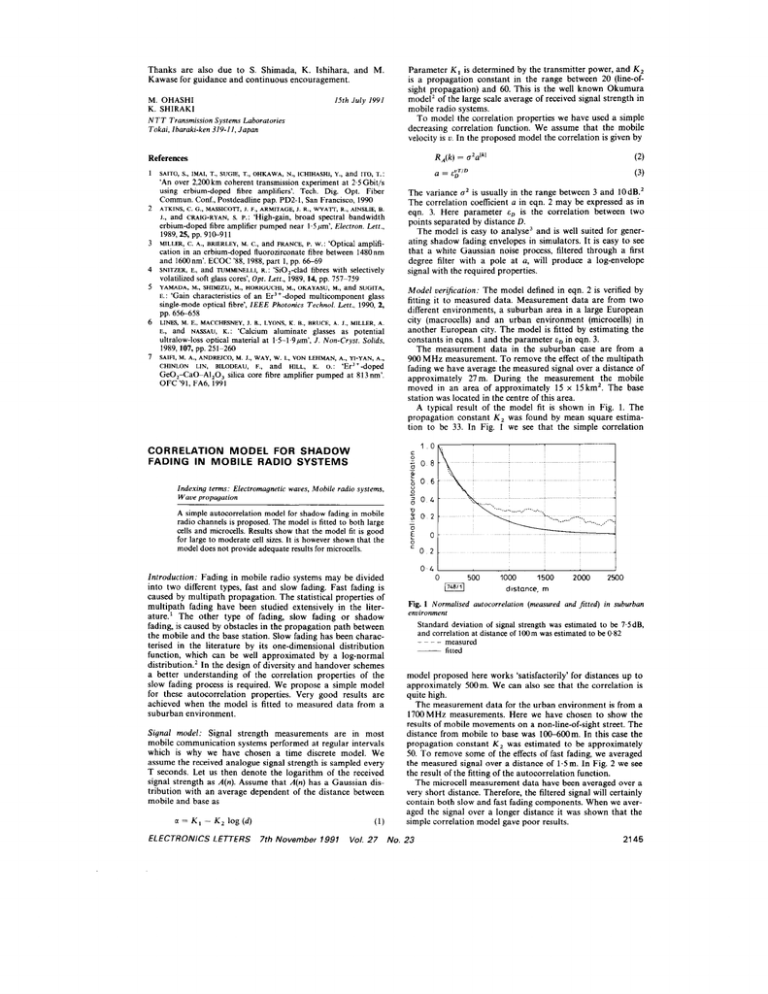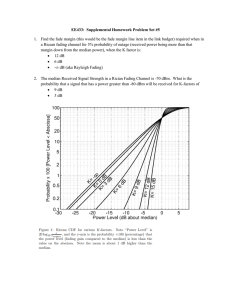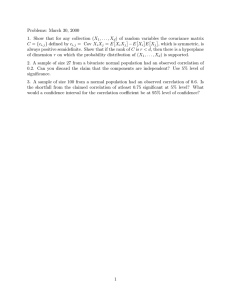Correlation model for shadow fading in mobile radio systems
advertisement

Thanks are also due to S . Shimada, K. Ishihara, and M. Kawase for guidance and continuous encouragement, M. OHASHI K. SHIRAKI N T T Transmission Systems Laboratories Tokai, Ibaraki-ken 3/9-11, Japan 15th July 1991 Parameter K , is determined by the transmitter power, and K , is a propagation constant in the range between 20 (line-ofsight propagation) and 60. This is the well known Okumura model’ of the large scale average of received signal strength in mobile radio systems. To model the correlation properties we have used a simple decreasing correlation function. We assume that the mobile velocity IS U. In the proposed model the correlation is given by References 1 2 3 4 5 6 R,(k) and ITO, T.: ‘An over 2,200 km coherent transmission experiment at 2.5Gbit/s using erbium-doped fibre amplifiers’. Tech. Dig. Opt. Fiber Commun. Conf., Postdeadline pap. PD2-1, San Francisco, 1990 ATKINS, C. G., MASSICOTT, I. f., ARMITAGE, J. R., WYATT, R., AINSLIE, B. I., and CRAIG-RYAN, s. P.: ‘High-gain, broad spectral bandwidth erbium-doped fibre amplifier pumped near 1.5&, Electron. Lett., 1989,25, pp. 91@911 MILLER, c. A., BRIERLEY, M. c., and FRANCE, P. w.: ‘Optical amplification in an erbium-doped fluorozirconatefibre between 1480nm and 1600nm’.ECOC ’88,1988,part I, pp. 6669 SNITZER, E., and TUMMINELLI, R.: SO,-clad fibres with selectively volatilized soft glass cores’, Opt. Lerr., 1989, 14, pp. 757-759 YAMADA, M., SHIMIZU, M., HORIGUCHI, M., OKAYASU, M., and SUGITA, E.: ‘Gain characteristics of an Er”-doped multicomponent glass single-mode optical fibre’, IEEE Photonics Technol. Lett., 1990, 2, pp. 656-658 SAITO, s., IMAI, LINES, M. E., MACCHESNEY, I. B., LYONS, K . B., BRUCE, A. I., MILLER, A. and NASSAU, K . : ‘Calcium aluminate glasses as potential E., 7 a = T., SUGIE, T., OHKAWA, N., ICHIHASHI, Y., ultralow-loss optical material at 1.5-1.9pm: J . Non-Cryst. Solids, 1989,107,pp. 251-260 M. J., WAY, W. I., V O N LEHMAN, A., YI-YAN, A., CHINLON LIN, BILOOEAU, F., and HILL, K. 0.: ‘Er”-doped GeO,-CaO-AI,O, silica core fibre amplifier pumped at 813nm’. OFC ’91, FA6,1991 SAIFI, M. A., ANDRWCO, = (2) u2aIk1 pJ (3) The variance U* is usually in the range between 3 and lOdB., The correlation coefficient a in eqn. 2 may be expressed as in eqn. 3. Here parameter E~ is the correlation between two points separated by distance D. The model is easy to analyse3 and is well suited for generating shadow fading envelopes in simulators. It is easy to see that a white Gaussian noise process, filtered through a first degree filter with a pole at a, will produce a log-envelope signal with the required properties. Model verification: The model defined in eqn. 2 is verified by fitting it to measured data. Measurement data are from two different environments, a suburban area in a large European city (macrocells) and an urban environment (microcells) in another European city. The model is fitted by estimating the constants in eqns. 1 and the parameter E~ in eqn. 3. The measurement data in the suburban case are from a 900 MHz measurement. To remove the effect of the multipath Fading we have average the measured signal over a distance of approximately 27 m. During the measurement the mobile moved in an area of approximately 15 x 15km2. The base station was located in the centre of this area. A typical result of the model fit is shown in Fig. 1. The propagation constant K, was found by mean square estimation to be 33. In Fig. 1 we see that the simple correlation CORRELATION MODEL FOR SHADOW FADING I N MOBILE RADIO SYSTEMS Indexing terms: Electromagnetic waves, Mobile radio systems, Wave propogation A simple autocorrelationmodel for shadow fading in mobile radio channels IS proposed. The model is fitted to both large cells and microcells. Results show that the model fit is good for large lo moderate cell sizes. It is however shown that the model does not provide adequateresults for microcells. Introduction: Fading in mobile radio systems may be divided into two different types, fast and slow fading. Fast fading is caused by multipath propagation. The statistical properties of multipath fading have been studied extensively in the literature.’ The other type of fading, slow fading or shadow fading, is caused by obstacles in the propagation path between the mobile and the base station. Slow fading has been characterised in the literature by its one-dimensional distribution function, which can be well approximated by a log-normal distribution.’ In the design of diversity and handover schemes a better understanding of the correlation properties of the slow fading process is required. We propose a simple model for these autocorrelation properties. Very good results are achieved when the model is fitted to measured data from a suburban environment, Signal model: Signal strength measurements are in most mobile communication systems performed at regular intervals which is why we have chosen a time discrete model. We assume the received analogue signal strength is sampled every T seconds. Let us then denote the logarithm of the received signal strength as A(n). Assume that A(n) has a Gaussian distribution with an average dependent of the distance between mobile and base as a =K, - K , log (4 ELECTRONICS LETTERS 7th November 1991 (1) Vol. 27 500 0 j748111 1000 1500 distance, m 2000 2500 Fig. 1 Normalised autocorrelation (measured and Jifted) in suburban environment Standard deviation of signal strength was estimated to be 7.5dB, and correlation at distance of l00m was estimated to be 0.82 _ - - _ measured fitted ~ model proposed here works ‘satisfactorily’ for distances up to approximately 500111. We can also see that the correlation is quite high. The measurement data for the urban environment is from a 1700MHz measurements. Here we have chosen to show the results of mobile movements on a non-line-of-sight street. The distance from mobile to base was 1 W 6 0 0 m . In this case the propagation constant K , was estimated to be approximately 50. To remove some of the effects of fast fading, we averaged the measured signal over a distance of 1.5m. In Fig. 2 we see the result of the fitting of the autocorrelation function. The microcell measurement data have been averaged over a very short distance. Therefore, the filtered signal will certainly contain both slow and fast fading components. When we averaged the signal over a longer distance it was shown that the simple correlation model gave poor results. No. 23 21 45 Results: If we use the results in Fig. 1 and assume that a mobile IS moving wtth a velocity of 50 km/h and that the sampling interval is 0.5s (as in GSM) our estimate of the . -_.. - . - $ * . _ _ . 15 . : . . 1. In the design of mobtle communicatton systems this large difference in the correlatton properties of the slow fading should be observed. Summary A correlation model for the received signal in shadow fading in a mobile radio system was proposed. Even though the model is simple results show good agreement wtth measurement data from suburban environments. In microcellular environments the signal envelope is ‘contaminated’ with multipath fading and the model predictions were less accurate. . 001 c signal will have almost the same value as the present sample. If we carry out the same calculahon for a mobile in a microcell we see that the correlation parameter a 1s much less than 5th September 1991 M. GUDMUNDSON -0 21 0 . 5 . 10 20 25 -..: 30 35 , I Radio Communication Systems Royal Institute of Technology Electrum-207 S-164 40 Kista, Sweden 40 45 distance. m Fig. 2 Normalised autocorrelation (measured and fitted) in urban environment Standard deviation of signal strength was estimated to be 4.3 dB, and correlation at distance of 10m was estimated to he 0.3 References correlation parameter a will be very close to 1. This implies a very high probability that the ‘next’ sample of the measured w. c.: ‘Microwave mobile communication’ (John Wiley & Sons, 1974) LEE, w. c. Y.: ‘Mobile communications engineering’ (McGraw-Hill, 1982) 3 GUDMUNDSON, M.: ‘Analysis of handover algorithm’. 41st IEEE Trans. Veh. Conf., 1991, pp. 537-542 FOUR-QUADRANT MULTIPLIER COMBINING SIGMA-DELTA A N D MULTIRATE PROCESSING TECHNIQUES greatly reduce the complexity of the multiplication algorithm and hardware requirements. By using the well known linearised models for the analysis of the ZA modulator: it can be _ _ _ _ measured ~ fitted 1 IAKFS, 2 serial inputs 1 bit at MF, Indexing term; Multipliers, Modulation, Integrated circuits A mixed analogucdigital solution combining sigmadelta and multirate processing techniques is proposed for realising MFs parallel outputs four-quadrant multipliers. This overcomes the major l i tations of purely analogue circuits and still achieves the attractive benefits of low power consumption and small chip size which cannot be afforded using digital signal processing techniques together with auxiliary analogucdigital and digital-analogue convertors. Introduction: Several approaches have been considered to implement in integrated circuit (IC) form the multiplication of two analogue signals,’-3 namely those either based on purely or employing a combination of both anaanalogue logue and digital circuits.’ Whereas the former can suffer from technology constraints yielding poor accuracy and reduced dynamic range, the latter can potentially offer as much precision as desired but this requires fine quantisation to minimise the noise power and thus complex auxiliary analoguedigital and digital-analogue convertors are needed. Furthermore, this obviously increases the power consumption and the silicon area for IC fabrication. We describe a mixed-signal analogue-digital architecture in which the high speed output hit stream of a sigma-delta (ZA) modulator is used to control the operation of a switchedcapacitor (SC) decimator for filtering and sampling rate reduction. The multiplication itself is accomplished in the charge domain and, depending on the values of capacitance ratios, can be defined with an accuracy as high as 0.1%. The range of the analogue input signals, with both positive and negative values, is limited only by the operation of the amplifiers in the circuits and the voltage reference needed in the ZA modulator. Architecture and operation principle: The proposed architecture, shown in Fig. 1, consists of a ZA modulator, a digital shift register and an SC decimator. The ZA modulator encodes one continuous-time input signal into a bit stream at high rate MF, and whose average is a good representation of the input signal. Such coarsely quantised signals (binary 01 representation) possess a high signal-to-noise ratio and can 21 46 riS. 1 s c k t i c bloc. diOerMt of digital multiplier four-qundront onolosue- shown that the signal plus noise output components may expressed as Y ( z )CY X(2) + (1 - z-’YE(z) (1) where n is the order of the system and X ( z ) and E(z), respectively, are the z transforms of the input signal and quantisation noise. As can be seen from the previous expression, the system is basically transparent to the signal whereas the quantisation noise is highpass shaped and pushed to higher frequencies. Thus, to achieve a good performance in terms of the signal-to-noise ratio, it is necessary to adequately lowpass filter those high frequency components. This is provided by the SC decimator which, in addition, also reduces the sampling rate of the signal from MF, to F,. Depending on the required specifications, we can always adopt for the SC decimator an efficient architecture for reducing the overall capacitance spread and relax the speed of the amplifier^.^.^ The hit stream at the output of the ZA modulator enters a digital shift register whose outputs control the operation of the input branches of the SC decimator as shown schematically in Fig. 2. When the controlling bit is ‘1’ the corresponding SC branch is configured in a positive charge transfer mode and when the controlling bit is ‘0’ it is configured in a negative charge transfer mode5s6 (we should note that the binary 01 representation adopted here actually corresponds, respectively, to minus and plus the voltage reference of the X4 modulator). Such an operation produces the multiplication ELECTRONICS LETTERS 7th November 1991 Vol. 27 No. 23


